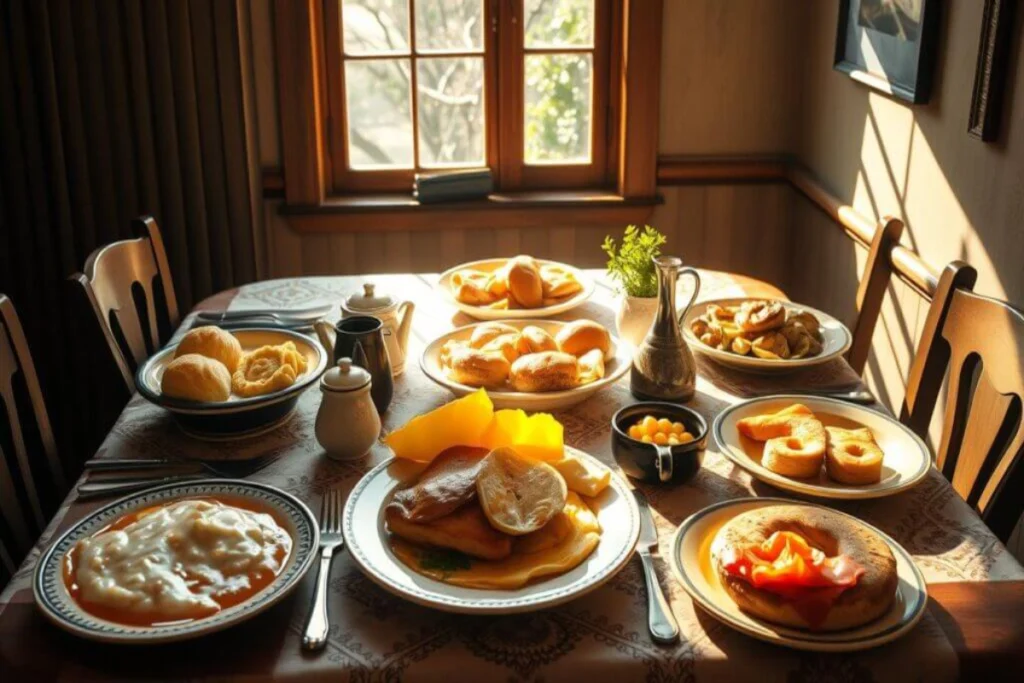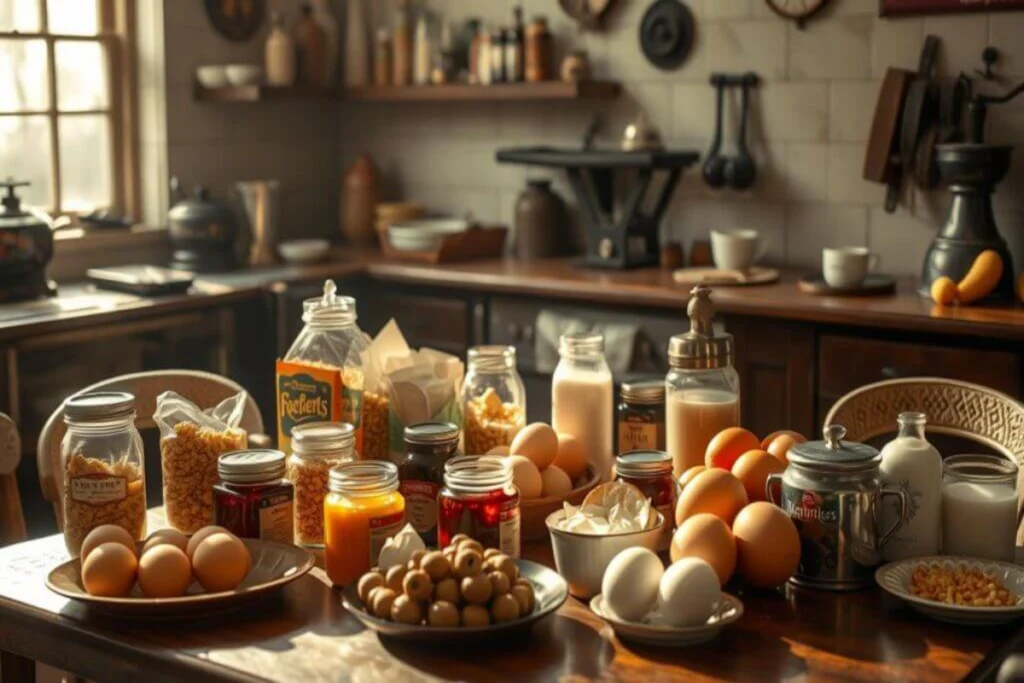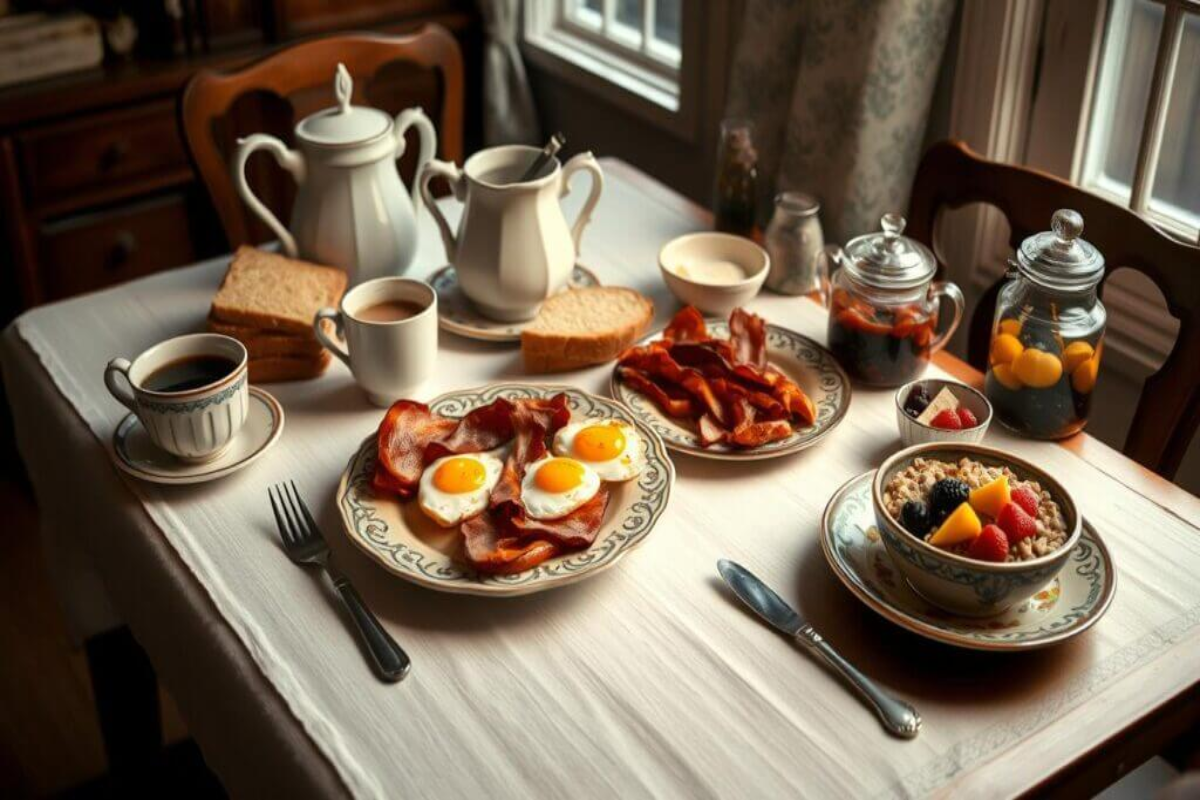Exploring American breakfast history shows big changes from today. Breakfast as we know it started in the mid-1800s. Before then, breakfast wasn’t a big deal in the U.S. The Boston Tea Party helped make coffee a key part of breakfast.
In 1910, eggs were a favorite, thanks to a doctor’s advice in 1620. New foods like granola, created in 1863, also shaped breakfast. The 1910s saw the rise of Puffed Wheat and Rice cereals, adding more choices.
Looking into 1910 American breakfast, you’ll find many options. These include porridge, bread in warm milk, and brown bread with butter and egg. These foods show how American breakfast evolved, influenced by culture and industry. Learning about breakfast history helps us understand its role in American food.
The Breakfast Landscape in 1910
Exploring breakfast trends in 1910, we see how culture shaped our morning meals. The term “breakfast” comes from breaking the fast of the night before. In 1910, breakfasts varied by culture and class, influenced by where you lived, your income, and what food was available.
In the United States, breakfasts in 1910 were a blend of old and new. Data shows 82% of homes ate eggs for breakfast, 72% had cured meats, and 64% enjoyed porridge. Coffee was also a favorite, with 55% of homes drinking it. These choices were shaped by European immigration and the growth of cities.
Overview of Breakfast Trends
Some key statistics from 1910 include:
- 78% of households prepared breakfast at home
- 62% of households purchased breakfast ingredients from local markets
- 38% of households used gas stoves for breakfast preparation
- The average weekly expenditure on breakfast ingredients was $2.50
Cultural Influences on Breakfast Choices
Culture greatly influenced breakfast choices in 1910. For instance, the French had a light breakfast of coffee, bread, and pastries. In contrast, Americans favored bigger meals with eggs, meat, and grains. These choices reflect the diverse backgrounds and traditions of Americans at the time.
| Breakfast Item | Percentage of Households Consuming |
|---|---|
| Eggs | 82% |
| Cured Meats | 72% |
| Porridge | 64% |
| Coffee | 55% |
Common Foods Eaten for Breakfast
In 1910, people had many breakfast food options. Bread, eggs, and meat were common in homes. You could enjoy different breads like cornbread and wheat bread with butter or make French toast.
Eggs were a favorite, often scrambled, fried, or boiled. Protein options like steak, cured ham, and smoked cuts were served with eggs and bread. This mix made for a filling breakfast..
Breakfast dishes like eggs Benedict, breakfast sandwiches, and creamed chipped beef over toast were popular. These dishes used easy-to-find ingredients. The lumberjack breakfast, with eggs, cured ham, smoked meats, sausage, and pancakes, was also a hit for a hearty start.
Meat choices were varied, including cured meat roll, or Taylor Ham, made in 1856 in the U.S. It was a favorite in some breakfast sandwiches. Breakfast foods in 1910 were simple yet satisfying, often made with local ingredients.
Regional Breakfast Differences in the U.S.
Breakfast in the U.S. varies a lot from place to place. The Northern and Southern states, and urban and rural areas have their own breakfast styles. Each area has its own favorite dishes and ways of cooking.
In the Northern states, you might find pancakes, waffles, and eggs on the menu. The Southern states, on the other hand, love biscuits, grits, and fried chicken for breakfast. Urban areas offer a mix of dishes from different cultures. But in rural areas, it’s all about the classic breakfasts.
Northern vs. Southern Breakfast Traditions
The Northern and Southern states have their own breakfast traditions. These are shaped by their history, culture, and where they are. Here are some popular Northern breakfast dishes:
- Oatmeal with fruit and nuts
- Scrambled eggs with smoked salmon
- Yogurt parfaits with granola and berries
On the other hand, Southern breakfasts often include:
- Biscuits and gravy
- Fried chicken and waffles
- Grits with cheese and smoked sausage
Breakfast in Urban vs. Rural Areas
Breakfast in urban and rural areas is different too. Urban areas have many breakfast choices, thanks to restaurants and cafes. But in rural areas, it’s all about traditional dishes made with local ingredients.

| Region | Breakfast Traditions |
|---|---|
| Northern | Pancakes, waffles, eggs |
| Southern | Biscuits, grits, fried chicken |
| Urban | Diverse range of options, international influences |
| Rural | Traditional dishes, local ingredients, homemade cooking |
The Role of Breakfast in Daily Routine
Breakfast has changed a lot over time. It used to not be a family meal for everyone. In the 1800s, breakfast times varied based on who you were and what you did.
In 1812, a Baltimore coffee house served breakfast from 7 am to 10 am. They offered cold and warm items like chocolate and tea. This was to meet the needs of different customers.
Today, your breakfast routine might include foods like eggs and orange juice. The time you eat breakfast is important. It can help you feel more awake and ready for the day.
In 1910, breakfast times were different for different people. This was based on their social class and job. Now, you can choose when and what to eat for breakfast, based on your own schedule.
Breakfast as a Family Meal
Eating breakfast together can be a great way to connect with your family. It can be a time to share and enjoy each other’s company. You can have pancakes or eggs together.
Think about when you eat breakfast. It could be a quick meal before school or a relaxed meal on weekends. This way, everyone can join in.
Timing of Breakfast in 1910
In 1910, breakfast times were not the same for everyone. They depended on your social class and job. But as cities grew and work schedules changed, breakfast times started to become more standard.
Now, you can pick your own breakfast time and foods. This lets you fit breakfast into your life in a way that works for you.
Here is a table summarizing the evolution of breakfast timing:
| Year | Breakfast Timing | Social Class |
|---|---|---|
| 1812 | 7 am – 10 am | Middle class |
| 1910 | Varying times | Working class and upper class |
| Present day | Flexible timing | All social classes |
Breakfast Beverages in 1910
In 1910, you had many choices for breakfast drinks. Coffee and tea were favorites, with many starting their day with a hot cup. There were also nutritional drinks like milk and juice.
Some popular breakfast drinks in 1910 included:
- Coffee: a staple in many households, often served with sugar and cream
- Tea: a popular alternative to coffee, often served with milk and sugar
- Milk: a nutritious beverage, often served with cereal or used in cooking
- Juice: a refreshing and noutriuuuons option, with options like orange juice becoming increasingly popular
For nutritional drinks, milk and juice were great choices. They provided essential vitamins and minerals to start your day. These drinks helped give you energy and nutrition for the day ahead.
The breakfast drinks of 1910 offered something for everyone. Whether you liked traditional coffee or tea, or something like milk or juice, there was a choice for you.
| Breakfast Beverage | Price (1910) |
|---|---|
| House Coffee (12 oz) | $3 |
| Seedling Farm Apple Cider | $4 |
The Impact of Industrialization on Breakfast
Industrialization changed breakfast a lot, bringing in convenience foods and canned goods. The United States quickly grew, and so did the food industry. This allowed companies like Kellogg’s and Post to start making foods on a big scale.
Now, people could easily find and use canned foods for breakfast. This made getting ready for the day a lot simpler. New foods like cereals became common in American homes.
Convenience Foods and Their Rise
Convenience foods like canned goods and easy-to-eat items became very popular. By 1909, Kellogg’s was making 120,000 cases of Corn Flakes every day. This was thanks to the transcontinental railroad, which helped brands like Kellogg and Post reach more people.
Canned Products and Ready-to-Eat Options
Canned fruits and veggies became a big deal in American kitchens. They were easy to get and use all year. Cereals also became popular because they were quick to make and needed little cooking.

Industrialization really changed breakfast, making it all about easy foods and canned items. As the food world keeps growing, it will be exciting to see how breakfast changes with new tech and what people want.
| Company | Product | Year Introduced |
|---|---|---|
| Kellogg’s | Corn Flakes | 1909 |
| Post | Grape-Nuts | 1909 |
Breakfast in Different Socioeconomic Classes
Breakfast choices vary greatly based on socioeconomic classes. Wealthy families enjoy a wide range of foods, like rare fruits and specialty meats. On the other hand, working-class meals are simpler and more budget-friendly, often featuring bread, eggs, and cheese.
The impact of immigration on breakfast is significant. People from various cultures introduce their own breakfast traditions. This diversity brings a wide range of options, from pancakes and waffles to huevos rancheros and shakshuka.
Here are some key differences in breakfast habits across different socioeconomic classes:
- Wealthy families: tend to eat more elaborate breakfasts, with a focus on quality ingredients and presentation.
- Working-class families: prioritize simplicity and affordability, often opting for quick and easy meals.
- Immigrant families: bring their own unique breakfast traditions, enriching the culinary landscape of their adopted country.
| Socioeconomic Class | Breakfast Habits |
|---|---|
| Wealthy families | Elaborate breakfasts with quality ingredients |
| Working-class families | Simple, affordable meals |
| Immigrant families | Unique breakfast traditions from their country of origin |
Famous Breakfast Dishes of the Era
The early 20th century had many tasty breakfast dishes. You might know pancakes with toppings like fruits or syrups. These treats were loved by many and are still popular today.
Griddle cakes and waffles were also favorites. They were topped with butter, jam, or honey. Whether you liked sweet or savory, there was something for everyone.
Some popular dishes from back then include:
- Pancakes with fresh fruits and whipped cream
- Griddle cakes with butter and jam
- Waffles with syrup and smoked cuts
These dishes were not just tasty. They also helped shape breakfast culture back then. They were often enjoyed at social events and in many homes.
Today, we still love pancakes, griddle cakes, and waffles. Their history and cultural importance make them interesting to learn about.
| Breakfast Dish | Popular Toppings |
|---|---|
| Pancakes | Fresh fruits, syrups, whipped cream |
| Griddle Cakes | Butter, jam, honey |
| Waffles | Syrup, smoked cuts, fresh fruits |
The Advent of Breakfast Cereals
As you look into the history of breakfast, you’ll see how breakfast cereals became a common choice. The late 19th and early 20th centuries saw a big change. Early brands like Kellogg’s and Post made breakfast easy and quick.
The first cereals were simple, made from grains with little processing. As time went on, the marketing got better. Companies aimed at families and kids to build loyalty. The mix of easy packaging, tasty flavors, and smart marketing helped cereals grow.
Brands like Cheerios from General Mills and Kellogg’s Corn Flakes stand out. They’ve kept up with what people want, offering many choices. The marketing to families helped them succeed, making cereals seem nutritious and good for breakfast.
But, in recent years, cereal sales have dropped. This is because people are looking for more wholesome options and changing their eating habits. Yet, with more online shopping and a need for quick breakfasts, sales are starting to rise again. When picking your breakfast, think about the breakfast cereals out there. Look at their ingredients and marketing to make a smart choice.
Nostalgic Reflections on Breakfast in 1910
Looking back at breakfast in 1910, we see how much it has changed. The nostalgic reflections of those days bring comfort and tradition. Yet, the breakfast evolution has brought big changes in food, cooking, and culture.
The lasting legacies of 1910’s breakfast foods still shape our mornings. Classics like pancakes and waffles are still favorites. The rise of easy-to-make foods and mass production has changed how we eat in the morning. Even the egg, a staple in 1910, is still loved and used in many dishes today.
Though ingredients and cooking methods have changed, the appeal of a good breakfast remains. It shows our need for nourishment, comfort, and connection. As you enjoy your breakfast, remember the rich breakfast traditions that have shaped our food culture.
FAQ
What were the common breakfast foods eaten in 1910?
In 1910, people enjoyed bread and butter, eggs, and meat for breakfast. They had cornbread, wheat bread, scrambled or fried eggs, and various meats.
How did regional and cultural differences influence breakfast habits in the U.S. in 1910?
Breakfasts varied a lot in the U.S. in 1910. The North and South, cities, and towns had their own special breakfasts.
What role did breakfast play in the daily routine in 1910?
Breakfast was a key meal in 1910. It was influenced by family status, jobs, and what food was available.
What were the popular breakfast beverages in 1910?
Coffee and tea were the top choices for breakfast drinks in 1910. There were also other nutritional drinks around.
How did industrialization impact breakfast in 1910?
Industrialization brought new foods like canned goods. This changed breakfast foods and how meals were made and eaten.
How did breakfast habits differ across socioeconomic classes in 1910?
Breakfasts were different for the rich and the working class in 1910. Immigration also played a role in what foods were available.
What were some of the famous breakfast dishes of the era?
Famous dishes included pancakes, griddle cakes, and waffles. Each had its own type and way of making.
How did breakfast cereals emerge and become popular in 1910?
Breakfast cereals started in 1910. Early brands were marketed to families, making them a hit for breakfast.

